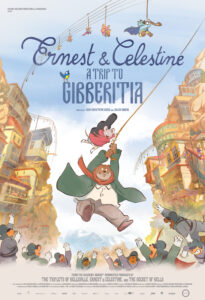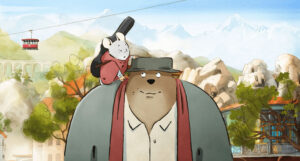Music and Visuals Soar in “Ernest & Celestine: : A Trip to Gibberitia”
Written by: Robin C. Farrell | August 31st, 2023

Ernest & Celestine: A Trip to Gibberitia (Julien Chheng/Jean-Christophe Roger, 2022) 3½ out of 4 stars.
Though Ernest & Celestine: A Trip to Gibberitia is a sequel to 2012’s Ernest & Celestine, and an adaptation of Gabrielle Vincent’s books, this film very much stands on its own. While it doesn’t explain how or why the titular characters are connected, their rapport conveys so much from the start. This is due, as well, to tremendous voice work from Lambert Wilson (Mrs. Harris Goes to Paris) and Pauline Brunner (Paris Follies).
The film opens with Celestine waking Ernest from hibernation. Naturally, he’s hungry and when there’s no food to be found in the kitchen, Celestine fetches Ernest’s one-of-a-kind violin so he might play in the square, but, in her haste, accidentally breaks it. The only craftsman he would entrust to repair it, however, is Octavius, who still lives in Ernest’s hometown of Gibberitia.

After Celestine eventually convinces him to go there, however, he finds the city much changed. Music is illegal, under a law that bears his name, a Resistance has formed, and the aforementioned Octavius is in hiding. No longer on a quest to merely repair the violin, Ernest has to decide whether to cut and run or stay and stand up for what’s right, both seeming to require a high personal cost.
The visuals are stunning, rendered in beautiful, hand-drawn and painterly style detail that weaves, unobtrusively, extensive detail in the environments and abstract, even metaphorical atmosphere. Directors Julien Chheng and Jean-Christophe Roger keep the pacing in perfect rhythm with the story; simple, but effective. The stakes are earned and potent. Even to the end of the film, the finale is high energy but never grows too ridiculous, nor is it laid on too thick. The symbolism is clear without ever feeling heavy handed. Music being outlawed is nothing new, particularly in a piece of entertainment largely made for children, but with the detail of “only one note is legal,” the whole thing takes on a slightly more tongue-in-cheek tone, while also somehow stinging more.

The musical score is pleasant but there aren’t any real stand-out musical moments. After all, the majority of the film is set amidst a musicless backdrop. However, music is presented here as more of a practice, even as an identity, rather than a finished work. The film is equally centered on systemic oppression as it is family dynamics; the pressure to adhere to cultural norms along with those of your parents and siblings. It’s a lovely and poignant presentation for younger viewers for whom this may be their first exposure to such concepts. For fans of Studio Ghibli’s Hayao Miyazaki (The Wind Rises) or Irish animation studio Cartoon Saloon (Wolfwalkers), for animation enthusiasts, and those both young and young at heart, this is absolutely one you’ll not want to miss.

